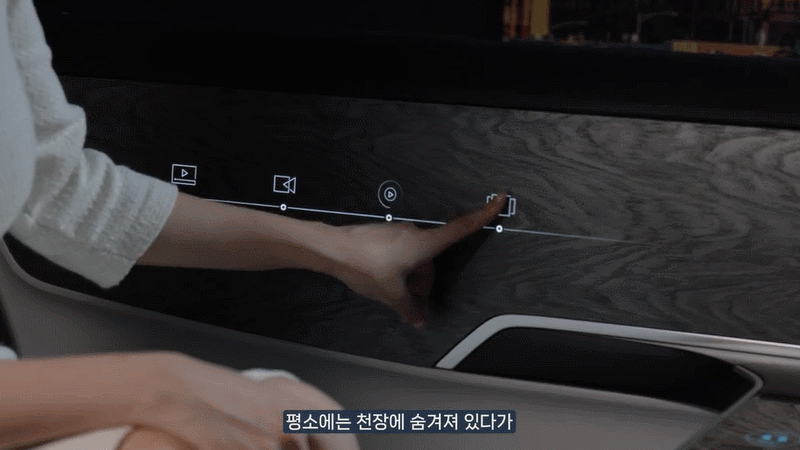
Hold onto your steering wheels because the automotive display market is accelerating at an astonishing pace! According to the Korean media, the global automotive display market is expected to reach approximately 15.96 trillion KRW this year. Key drivers behind this rapid growth include the ‘Screenification’ trend, where the size and number of in-vehicle displays are increasing, and the rising demand for high-resolution displays due to the importance of in-car infotainment systems.
As displays in vehicles continue to offer more functions, LG Display is leading the way with continuous innovation in automotive display technology! To dive deeper into LG Display’s groundbreaking automotive OLED technology, Haerin Kim from the Automotive Sales Team and Jijung Park from the Automotive Advanced Product Planning Team will guide us through an interactive discussion. Let’s see what they have to say!


Jijung Park: As you can see from the concept car, one of the most noticeable changes between older and newer cars is the cluster. The shift from analog to digital displays has made a huge difference!
Haerin Kim: Among these advancements, automotive OLEDs are gaining attention in the SDV (Software-Defined Vehicle) era. Let’s dive deeper into LG Display’s Tandem OLED technology, as well as P-OLED and ATO products, and see how they’re shaping the future of mobility!
Brighter and Longer Lasting: The Innovation of ‘Tandem OLED’ with Two-stacked Organic Light Emitting Layers

Jijung Park: LG Display’s core technology for automotive displays is Tandem OLED, which uses a technology where two organic light emitting layers are stacked, maintaining the same thickness as conventional single-layer OLEDs but delivering even brighter screens.
Haerin Kim: And because the energy is distributed across two layers instead of one, Tandem OLED consumes less energy and lasts longer, ensuring stability over time.

Jijung Park: Safety is always the top priority while driving, and a high level of brightness is essential so drivers can clearly see the display, even on sunny days. Plus, cars need to function in extreme temperatures—whether parked outside in scorching summers or freezing winters. That’s why Tandem OLED is designed to perform flawlessly in both high and low temperatures.
‘P-OLED’, Bringing New Experiences to Mobility Beyond Design

Jijung Park: Let’s take a look at P-OLED, which uses our Tandem OLED technology. The ‘P’ stands for plastic, as this OLED uses a flexible plastic substrate, allowing it to bend and adapt to various designs.
Haerin Kim: Since the interiors of cars are usually made up of irregular curves. P-OLED’s flexibility lets it be smoothly integrated into the vehicle, enhancing the overall ergonomic design. As we move towards the era of autonomous driving, this flexibility also enables more diverse display form factors.

Jijung Park: You can see the 32-inch slidable OLED here. It stays hidden in the ceiling until the user lowers it, making efficient use of limited space inside the vehicle. With this, you can easily enjoy movies, watch the news, or even join video calls—all from the comfort of your car.
‘ATO’, High OLED Quality Meets Cost Efficiency

Haerin Kim: Another product applying Tandem OLED technology is an Advanced Thin OLED(ATO). It replaces the plastic substrate used in P-OLED with a glass substrate, which allows us to offer it at a more affordable price point.

Jijung Park: What’s the secret behind ATO’s impressive cost-effectiveness?
Haerin Kim: The reason ATO can offer a reasonable price lies in its manufacturing process. The glass substrate used in ATO simplifies the production process, allowing us to lower manufacturing costs and improve yield rates, thereby achieving price competitiveness. Additionally, since it uses a thinner glass substrate than other OLED products, ATO boasts a sleek and slim design.

Haerin Kim: We can’t overlook the eco-friendly aspect of LG Display’s automotive OLED! In January, LG Display received the Product Carbon Footprint (PCF) certification from TÜV Rheinland, a global certification body. Thanks to our unique ‘Light Control Film Integration Technology’, we were able to reduce carbon emissions by about 18% over the product life cycle.
Jijung Park: With outstanding image quality, high design flexibility, eco-friendliness, lightweight construction, and low power consumption—it’s clear why LG Display’s automotive OLED is receiving so much attention!
LG Display’s Automotive OLEDs: The Choice of Global Automotive Brands

Haerin Kim: As a result, LG Display has successfully partnered with various global automotive brands to develop and manufacture vehicles equipped with our OLED products.
Jijung Park: As the application of displays in cars continues to increase and expectations for fully autonomous driving rise, automotive displays are playing a critical role. LG Display is committed to leading the future of mobility by providing unprecedented driving experiences and smart environments. Stay tuned—the journey is just beginning!








